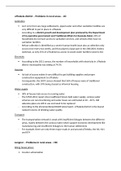uThekela district – Problems in rural areas – LIC
Sanitation
As it is far from any large settlements, piped water and other sanitation facilities are
very difficult to put in place in uThukela
- According to a district growth and development plan produced by the Department
of Co-operative government and Traditional Affairs for Kwazulu-Natal, 23% of
households do not have access to sanitation services, and schools often have no
sanitation facilities
- Refuse collection is identified as a severe human health issue also as collection only
occurs once every two weeks, and thus played a large part in the 200/2001 cholera
outbreak, as only 35% of uThukela has access to waste water facilities (sewers etc)
Electricity
According to the 2011 census, the number of households with electricity in uThukela
district municipality was sitting at 74.5%
Housing
Its lack of access makes it very difficult to get building supplies and proper
construction equipment to uThukela
- Consequently, the 2007 census showed that 56% of houses were of traditional
construction, with 59% being classed as informal housing.
Water supply
30% of houses lack access to running water
- The MTAS 2012 report cites insufficient future bulk water supply, various water
schemes are non-functioning and water losses are estimated at 40 – 60 %. Old
asbestos pipes are still in use and need to be replaced
- According to the aforementioned DGDP plan/report, uThukela district is the lowest
ranked in terms of drinking water quality
Transport
The transportation network is weak with insufficient linkages between the different
areas, mainly between the various nodes which support economic development like
manufacturing and insufficient linkages to the human settlements
- For example, there are only three major roads in and around uThekela, the N3, N11
and R74
Longnor – Problems in rural areas – HIC
Rising house prices:
1. Counter-urbanisation
, - Average house price was £282,000 between 2004-2009
- Demand for houses shown as wooden lodges at Longnor Wood Holiday Park retail
for £99,000
2. Local resources
- Houses must be built from local Daisy Knoll stone due to protected status of the
area, increasing house prices
Outward migration:
- Between 1971-1991 50% of 16–20-year-olds left
Service closure
1. Secondary school children must commute to Leek, a town 10 miles away, to the
nearest school, while the primary school, St Bartholomew’s, is only open 2 days a
week
2. The Red Bull Inn closed and has become an art gallery
3. The nearest hospitals are in Buxton, Leek and Bakewell, the nearest of which is a 6
mile drive
Poor employment opportunities
1. In 1990s the financial aid schemes ended, seeing the internet cafe and pub close by
2015, with the chip shop only open a few days a week
UK – Impacts of urbanisation in HIC
1. High house prices
- As of 2023, average house price in the UK is £272,000, compared to £504,000 in
London
2. Homelessness
- In 2019 the Guardian did an expose on a council in West London who were using
storage containers as makeshift council housing
- Kensington and Chelsea have over 6000 counted homeless people
3. Crime
- In 2020, the drug-related crime rate was 7 per 1000, compared to the UK average of
5.8 per 1000
4. Pollution




